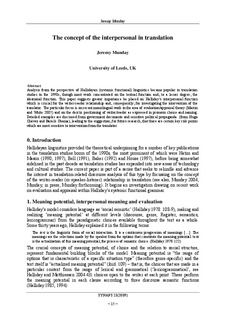| dc.description.abstract | Analysis from the perspective of Hallidayan (systemic functional) linguistics became popular in translation
studies in the 1990s, though most work concentrated on the textual function and, to a lesser degree, the
ideational function. This paper suggests greater importance be placed on Halliday’s interpersonal function
which is crucial for the writer-reader relationship and, consequently, for investigating the intervention of the
translator. The particular focus is on recent monolingual work in the area of evaluation/appraisal theory (Martin
and White 2005) and on the deictic positioning of writer/reader as expressed in pronoun choice and naming.
Detailed examples are discussed from government documents and sensitive political propaganda (from Hugo
Chávez and Barack Obama), leading to the suggestion, for future research, that there are certain key risk points
which are most sensitive to intervention from the translator. | nb_NO |
